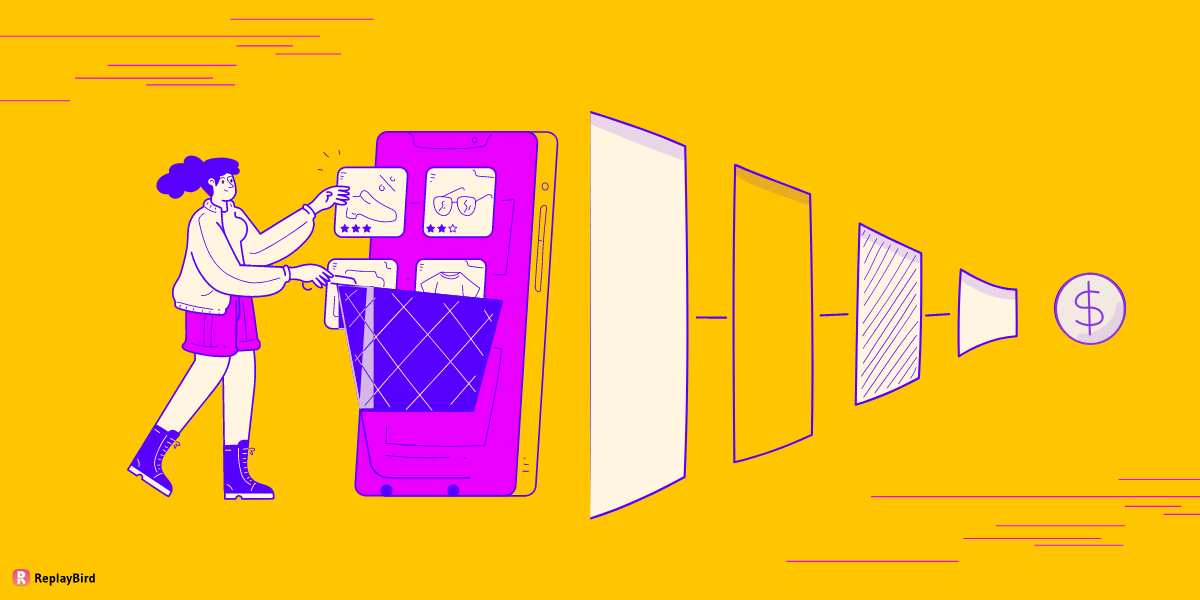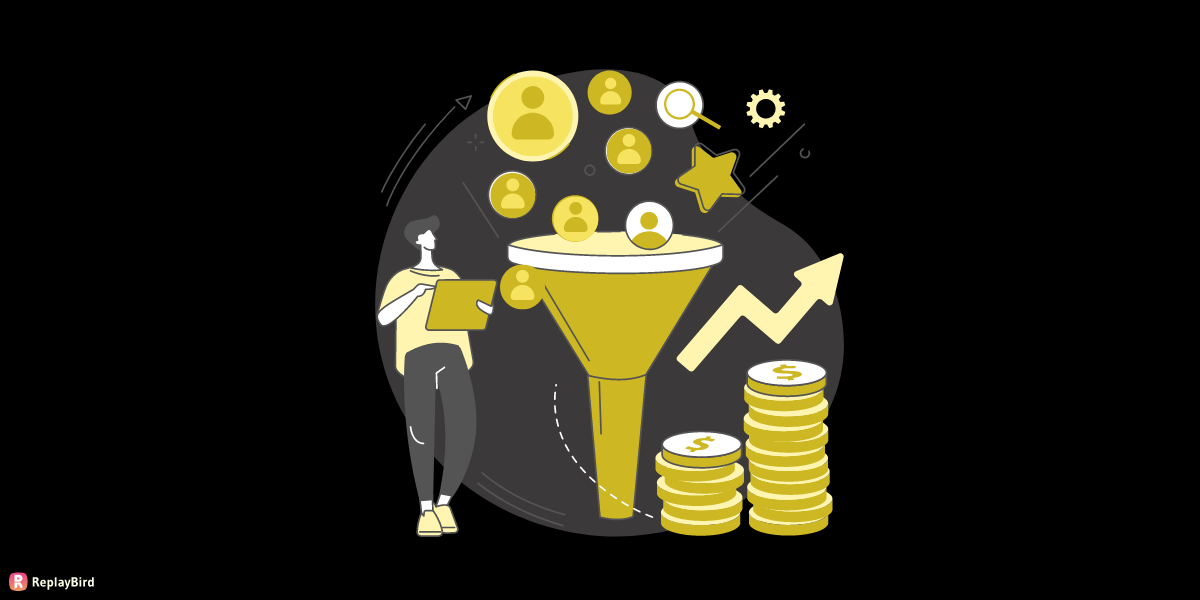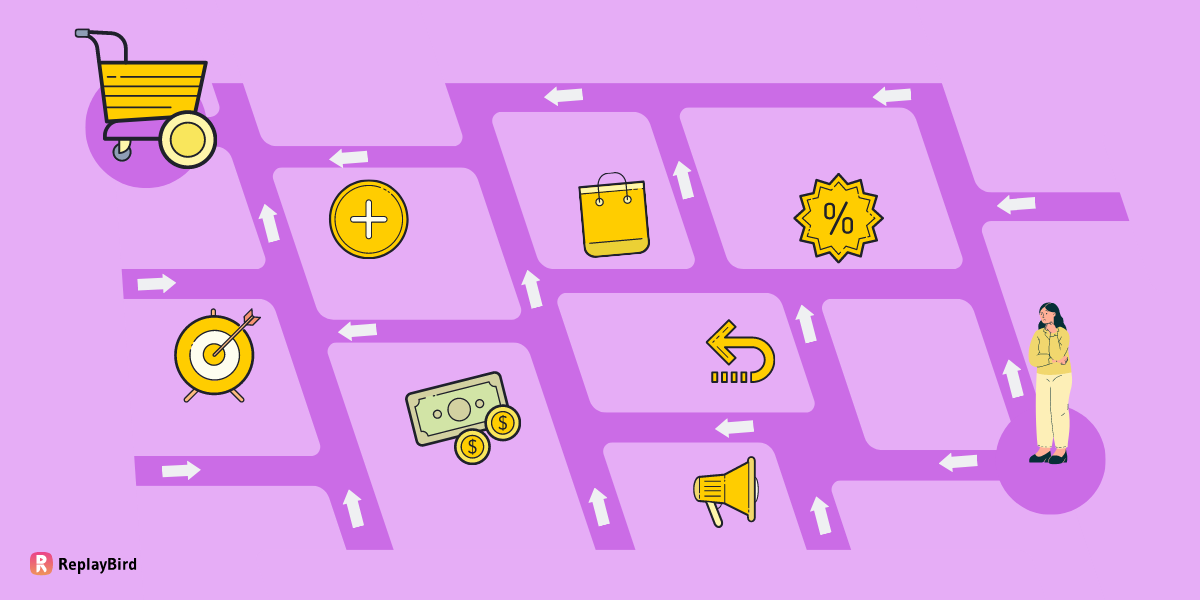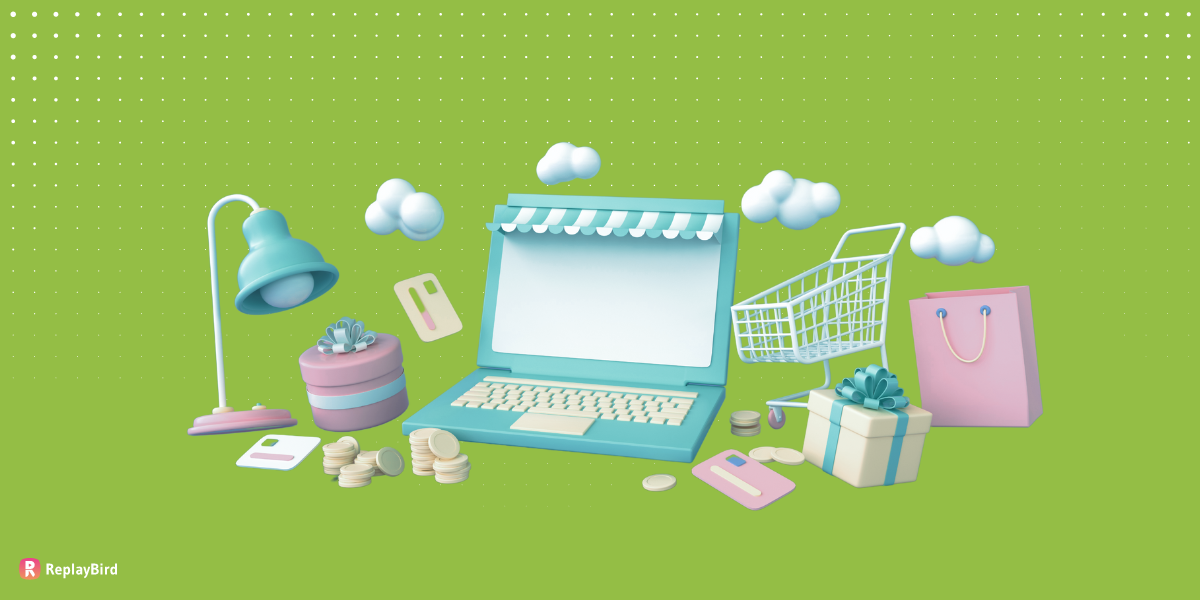Funnel analysis — a robust tool that unlocks the insights to successful customer conversions and business growth. Understand how potential customers navigate through your website or marketing campaigns, and how to optimize every step of their journey.
Picture a funnel, wide at the top and gradually tapering down, guiding visitors on from their first interaction to the final destination — a conversion, be it a purchase, sign-up, or subscription.
In this blog, we'll break down the concept of funnel analysis, explore its captivating benefits, and equip you with the knowledge to perform your very own analysis.
Whether you're a seasoned marketer, an entrepreneur, this blog will help you in understanding funnel and use it more efficiently than ever.
- What is Funnel Analysis?
- Funnel Analysis Example
- Conversion Funnel Analysis: Explained
- Funnel Analysis Errors to Avoid
- How to Perform Funnel Analysis?
- Steps to Create your First Funnel Analysis
- Benefits of Performing Funnel Analysis
What is Funnel Analysis?
Funnel analysis is a technique used in marketing and analytics to track and analyze the steps that users or customers take to achieve a specific goal, such as making a purchase or signing up for a service.
The term "funnel" is used because, like a real-life funnel, the number of users typically decreases at each step of the process as some drop off or exit before reaching the conversion goal.
Funnel analysis is crucial in understanding and optimizing the user journey through predefined steps. Businesses can gain valuable insights into user behavior by tracking users as they progress from the initial stage to the final goal or conversion point.
The main aim of funnel analysis is to identify potential areas of improvement or bottlenecks where many users drop off. This information allows businesses to make data-driven decisions to enhance user experience and boost conversions.
Some users may drop off throughout each step, leading to a gradual decrease in the number of users from the initial stage to the final conversion stage.
Funnel analysis can be applied to various aspects of business, such as marketing, sales processes, website user flows, app interactions, and more.
Funnel Analysis Example
Funnel analysis can be applied in various contexts, and different types of funnels can be analyzed based on the specific goals and processes involved wth any kind of innovation. Here are the top three types of funnels analysis for businesses to follow:
#1 E-Commerce Conversion Funnel Analysis
This is the most common type of funnel analysis, focusing on tracking and analyzing the steps users take to convert, whether it's making a purchase, signing up for a service, or completing any desired action.
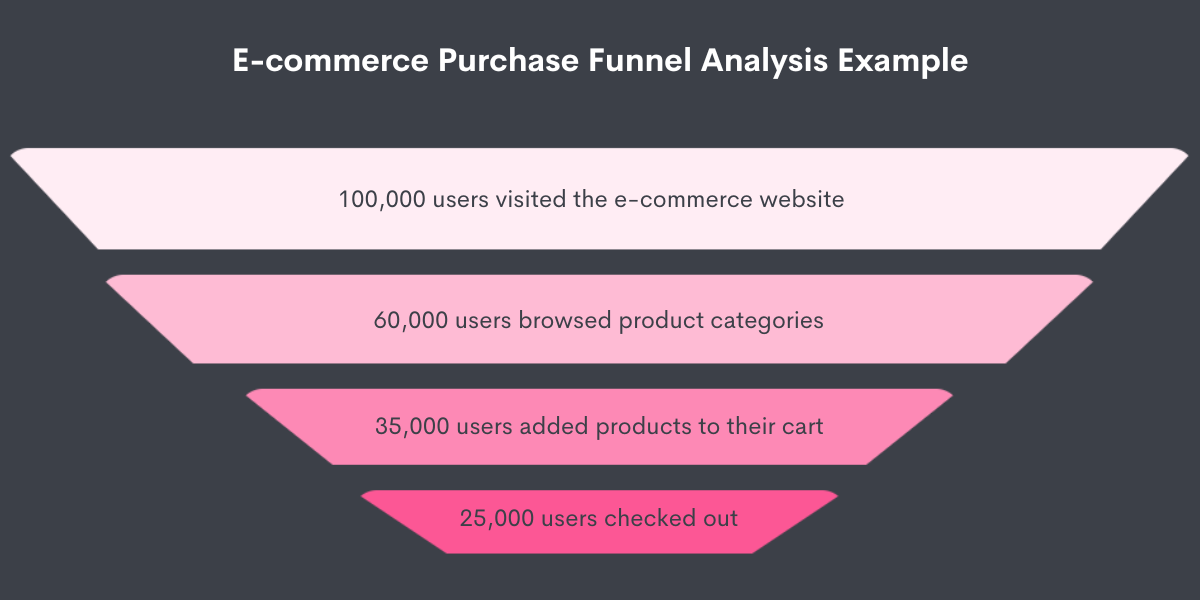
In this funnel analysis example, we can see that there was a drop-off of 40% of users from the awareness stage to the interest stage, another 41.67% drop-off from the interest stage to the consideration stage, and a 28.57% drop-off from the consideration stage to the conversion stage.
Finally, there was a retention rate of 88% from the conversion stage to the retention stage.
#2 Sales Funnel Analysis
Similar to the marketing funnel, the sales funnel focuses specifically on the steps a potential customer goes through in the sales process, from initial contact with a sales representative to closing the deal.
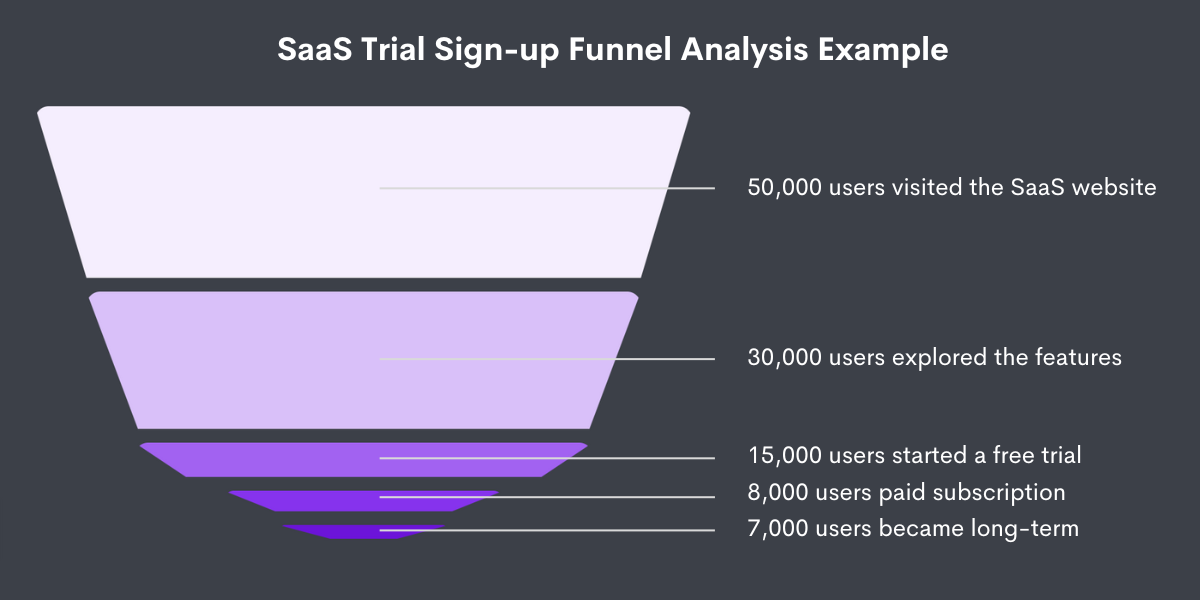
In this example, we can see that there was a drop-off of 40% of users from the awareness stage to the interest stage, another 50% drop-off from the interest stage to the consideration stage, and a 46.67% drop-off from the consideration stage to the conversion stage.
Finally, there was a retention rate of 87.5% from the conversion stage to the retention stage.
#3 Lead Generation Funnel Analysis
This funnel analysis is relevant to businesses looking to generate leads or potential customers. It tracks the steps users take from initial contact to becoming qualified leads for sales teams.
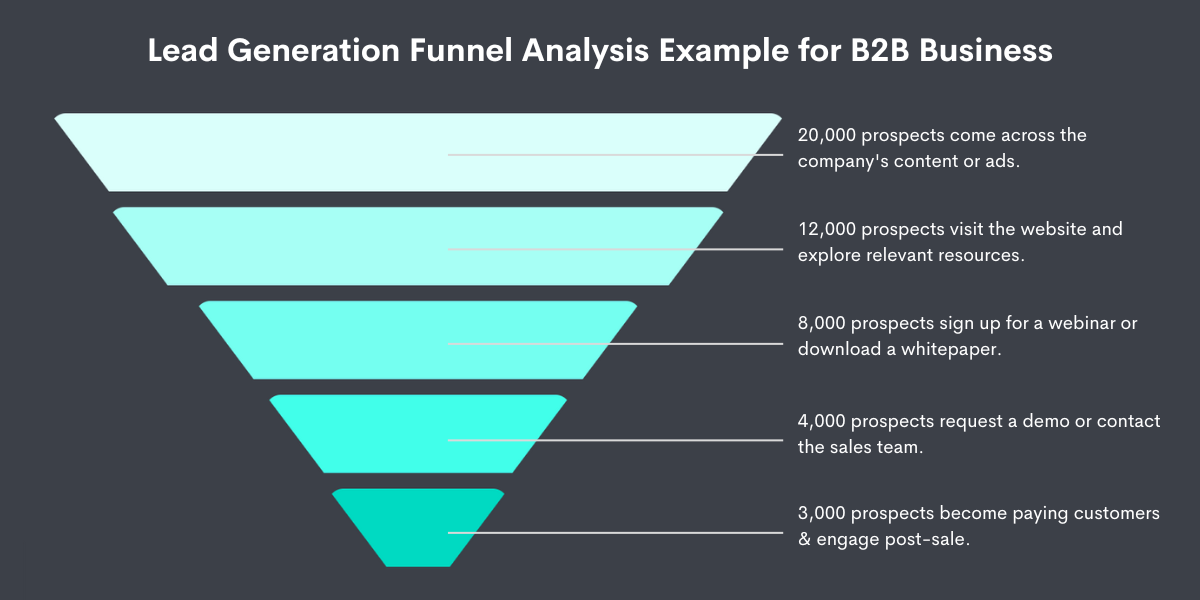
In this example, we can see that there was a drop-off of 40% of prospects from the awareness stage to the interest stage, another 33.33% drop-off from the interest stage to the consideration stage, and a 50% drop-off from the consideration stage to the conversion stage.
Finally, there was a retention rate of 75% from the conversion stage to the retention stage.
#4 Marketing Funnel Analysis
Also known as a sales funnel flow, this type of analysis follows the steps users take from initial awareness of a product or service to becoming paying customers. It includes stages like awareness, interest, consideration, and decision-making.
#5 User Engagement Funnel Analysis
This type of funnel analysis focuses on tracking user interactions and engagement with a website, app, or platform. It helps businesses understand how users interact with different features and content.
#6 Subscription Funnel Analysis
Often used by subscription-based businesses, this analysis tracks the user journey from subscription sign-up to ongoing renewals or churn. It helps optimize the subscription process and reduce churn rates.
Conversion Funnel Analysis: Explained
Conversion funnel metrics as a essential tool that businesses use to understand how people go from hearing about a product or service to actually buying it or taking some desired action. It's like a journey with different stages that potential customers follow, and as they move forward, the number of people involved tends to decrease, just like a funnel flow gets narrower at the bottom.
The cool thing about this funnel metrics is that it helps businesses get to know their customers better. It shows where potential customers might be getting stuck or dropping off, so businesses can figure out what's working and what needs a little adjusting.
With this framework, businesses can gather all sorts of valuable info about user behavior. They can see where people are coming from, like whether they found out about the product through social media, or ads. They can also find out what catches people's interest and how they engage with the brand – do they check out the website, read some blog posts, or maybe watch cool videos?
By seeing how people go through the different stages of the funnel flow, businesses can make the whole process even better. They can smooth out any bumps, simplify things, and create a super user-friendly experience to increase the chances of people actually doing what the business wants – like buying something or signing up for a service.
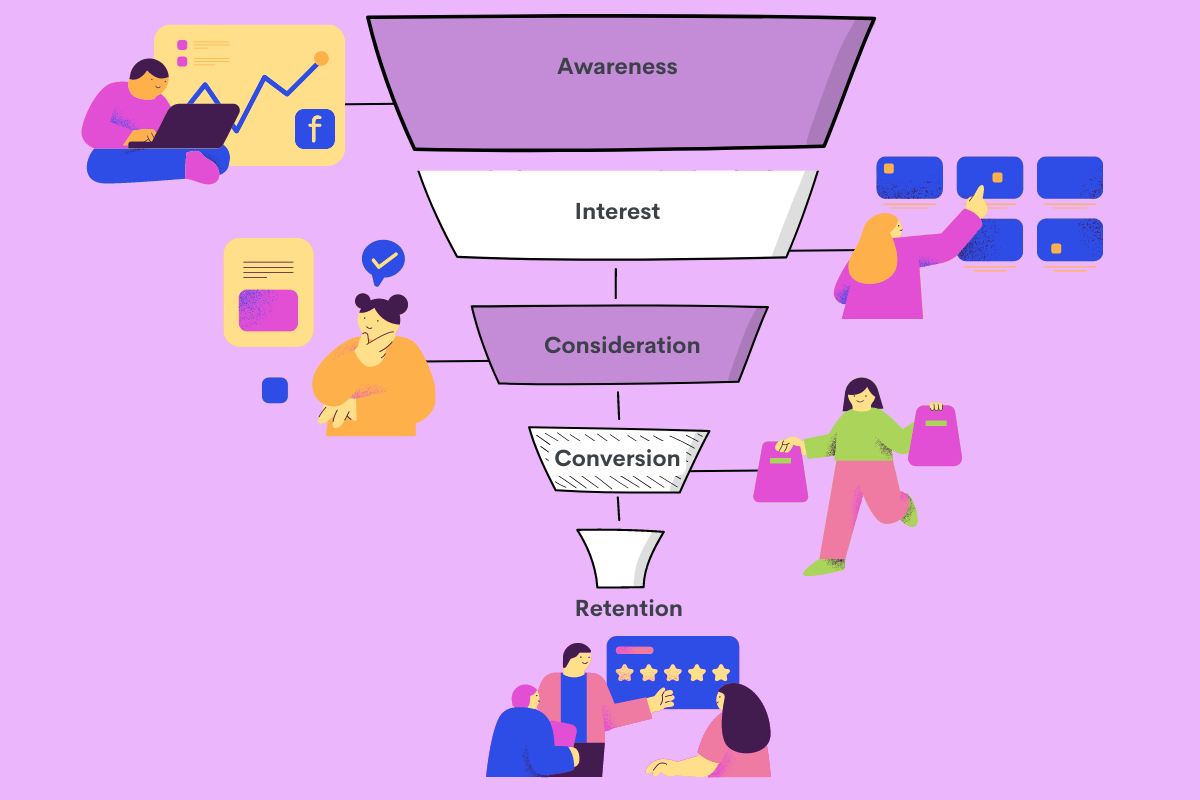
Let's dive deeper into conversion funnel analysis!
- Awareness: At the top of the funnel flow, potential customers start hearing or getting impressions on a product, service, or brand – through all sorts of marketings places like social media, online ads, blogs, or even from friends about it. It's all about how manny have been grabbed into the attention about the product.
- Interest: In this stage, potential customers really dig in and want to know more. They'll visit the company's website, check out the blogs, watch informative videos, and even chat with the brand on social media. When your customer comes down from just know your brand to thinking about buying your product, keeping them intrigued.
- Consideration: Potential customers start thinking, "Hmm, is this the right fit for me?" They might compare prices, read reviews from happy customers, ask friends for opinions, or maybe even try out a demo. We want them to feel confident and at ease, like our product wll make thir life more easier. Now at this point, the customer is ready with some money and want to make sure that the product is really worth the money they spent on.
- Conversion: This conversion stage is where potential customers decide to buym, after all they need it now. They might buy your product, sign up for your service, or join the newsletter. Now that the customer is converting, they are not anymore potential customers but they are oour real paid customer, into the product.
- Retention: We've generated a revenue with our converted customer but it isn't over. The final stage is all about keeping, once customers have joined our business, we start offering our customer support, making sure they have better using experience, and providing loyalty rewards, other offers or even ask for a feedback. Now that the customer is offen reminded about our product in their use, and may definitely have interest in again buy the product. This makes into the final conversion funnel customer retention.
Funnel Analysis Errors to Avoid
- Being specific about each stage of the funnel metrics is the key. Overlapping steps can lead to confusion when analyzing user behavior and conversion rates.
- Technical errors on the website or tracking platforms can result in inaccurate data collection for funnel metrics. Regularly analyze errors and validate data sources to ensure accuracy.
- Ignoring the account for seasonality and trends in the data can lead to misinterpretation of conversion rates and mistaken conclusions.
- Missing data can lead to incomplete insights, making identifying essential drop-off points difficult.
- Ignoring cross-device behavior can lead to inaccurate funnel analysis, as users may appear to drop off when, in reality, they are continuing their journey on a different device.
- Analyzing the funnel metrics without segmenting data based on relevant factors can lead to missing valuable insights about different user groups and their behaviors.
How to Perform Funnel Analysis?
The first step is establishing clear and specific goals to begin a funnel analysis journey. Take a moment to decide what you want to achieve with your analysis. Are you looking to increase conversion rates to boost sales? You may want to enhance the user experience on your website to keep visitors engaged and satisfied.
You aim to optimize your marketing efforts to reach a wider audience and generate more leads. Whatever your objectives, having well-defined goals will be the guiding light for your entire analysis.
Once your goals are set, the next essential step is to create a visual representation of your conversion funnel. Imagine it as a roadmap guiding your potential customers from the initial awareness stage to the ultimate conversion or desired action. This funnel flow map will provide a clear overview of the customer journey analysis and help you visualize the stages involved.
With your funnel flow in hand, it's time to gather relevant data from various sources. Don't limit yourself to website analytics; explore other data repositories like CRM systems and marketing platforms to comprehensively understand user behavior at each funnel stage with conversion funnel analytics. The more data you collect, the richer your insights will be.
As you are into the data, identify right product metrics for each funnel flow. These metrics will serve as checkpoints, allowing you to measure progress and track performance throughout the product metrics. Typical KPIs include the number of website visitors, click-through rates, sign-ups, and conversions.
To gain deeper insights into user behavior, analyze the data based on relevant factors like demographics, traffic sources, or customer segments. This segmentation will help you understand how different groups of users interact with your funnel and uncover patterns that might not be apparent in aggregated data.
Finally now comes the inspection work – analyze the data to identify the funnel's drop-offs and potential pain points. Focus on areas where users are leaving the journey or encountering obstacles. Understanding these pain points is crucial as they point you toward areas that require improvement.
Steps to Create Your First Funnel analysis with ReplayBird
Step 1: Go to the Funnel Analytics Page - Access the conversion funnel analytics section. This might be a built-in feature of a website analytics tool like ReplayBird.
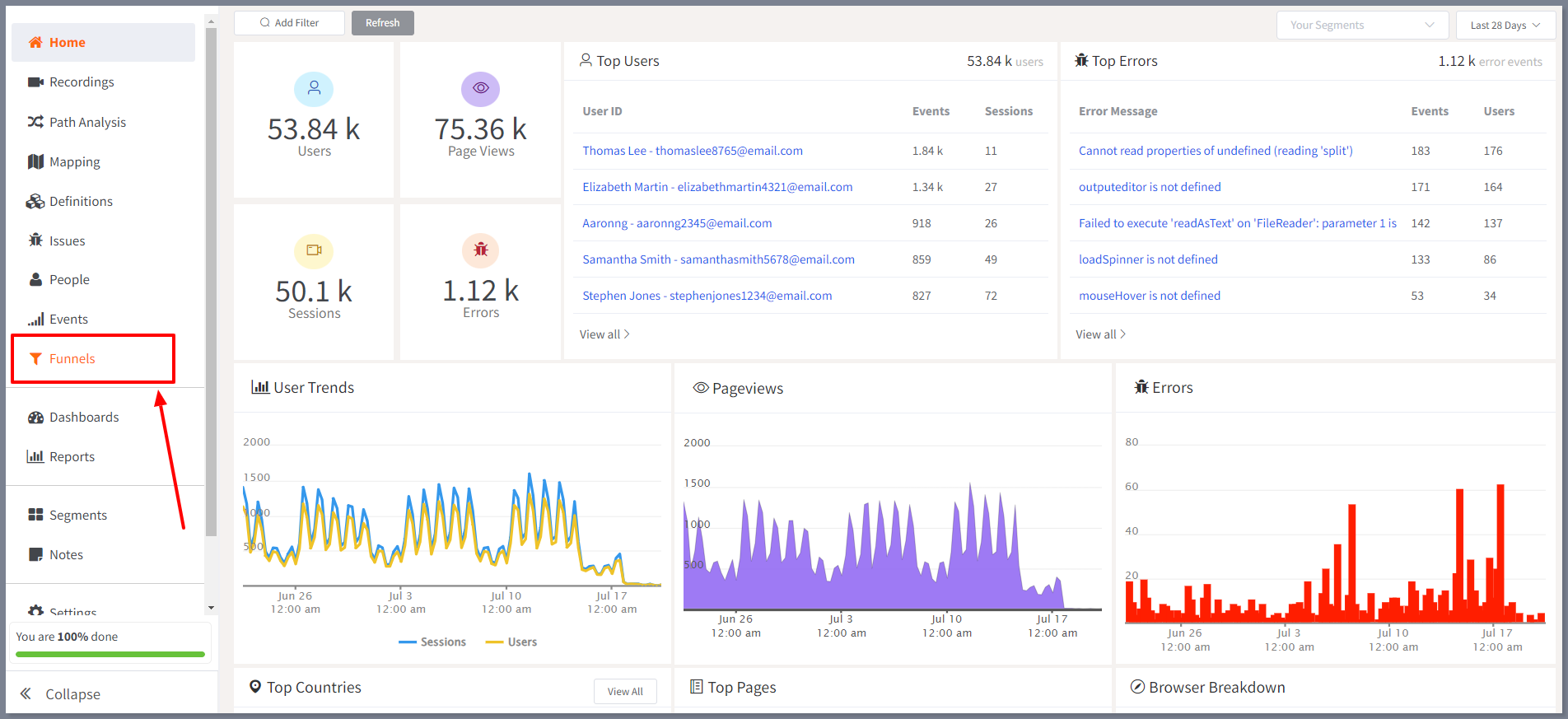
Step 2: Add/Select Initial Path - Start by defining the initial path or entry point for your funnel flow. This could be a specific landing page, advertisement, or any other entry point you want to track. This initial step helps identify where users came from and entered the funnel.

Step 3: Add Additional Steps - After setting the initial path, add the subsequent steps or stages that you want to monitor. These steps represent the user's journey through your website or process, such as visiting certain pages, completing specific actions, or interacting with certain elements.

Step 4: Generated Conversional Funnel Analysis - As users move through the funnel, you can track how many users advance to the next step and how many drop off at each stage. The conversion rate represents the percentage of users who successfully complete the previous step and proceed to the next one.

Step 5: Find the Conversion Rate - The conversion funnel analytics chart will display the conversion rates at the top of the chart container or at the end step of the funnel flow. These conversion rates help you understand the effectiveness of each stage and identify potential areas for improvement.
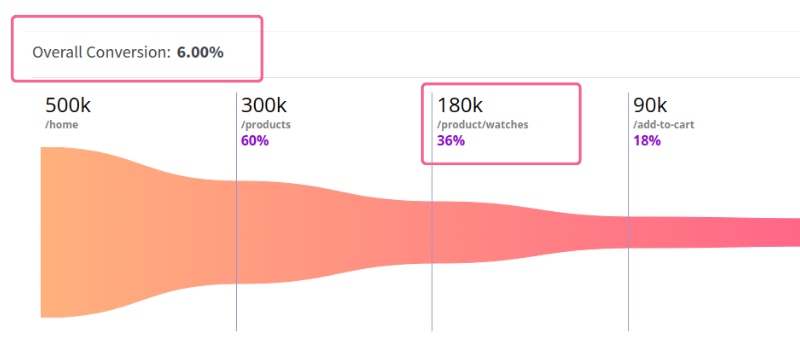
Step 6: Filter Funnel Steps with Entities - Perform user-specific investigations, segment your audience, identify user drop-offs, and personalize experiences. These insights, in turn, can drive strategic improvements and lead to better overall funnel performance and customer satisfaction.
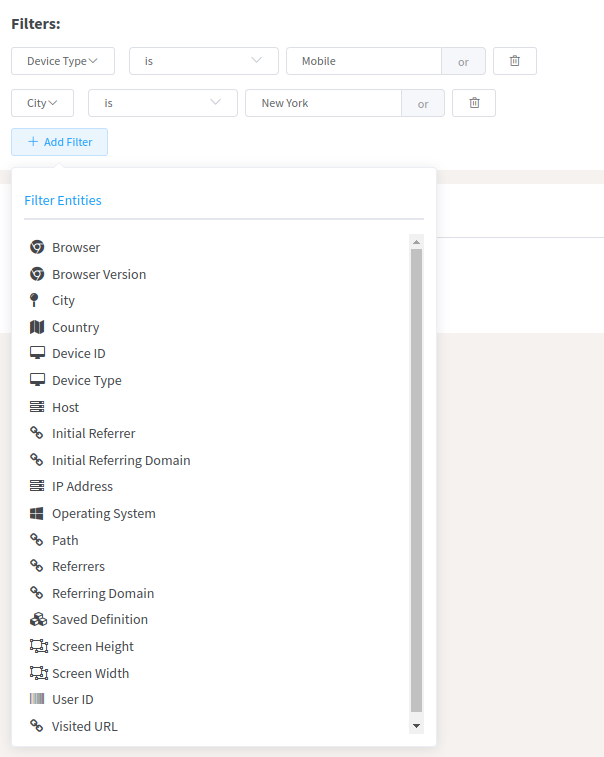
Step 7: Reset the Chart Steps - If you want to start over or make changes to the funnel, you can use the "reset steps" button to clear the existing data and set up a new funnel configuration. This allows you to experiment with different funnel setups to optimize user journeys and conversions.
Benefits of Performing Funnel Analysis
- Understand User Behavior: Funnel analysis provides valuable insights into how users interact with a website, You can understand user preferences, pain points, and behavior patterns by tracking their progression through different stages.
- Identify Drop-off Points: Funnel analysis helps identify specific steps in the user journey where many users drop off or abandon the process this lets you pinpoint areas needing improvement and address potential bottlenecks.
- Optimize Conversion Rates: Businesses can make informed decisions to optimize their processes and user experiences. Addressing issues identified in the funnel can increase conversion rates, resulting in more successful outcomes.
- Track Marketing ROI: Funnel analysis allows businesses to track the Return on Investment (ROI) of various marketing efforts at each user journey stage. It helps understand which marketing channels or campaigns are most effective in driving conversions and revenue.
- Customer Segmentation: Funnel analysis facilitates audience segmentation based on their behavior at different stages. This segmentation provides valuable insights into user groups, allowing businesses to target them more effectively with personalized marketing strategies.
- Improve Product Development: By understanding where users encounter difficulties or drop off during the funnel stages, businesses can make necessary improvements to their products or services. This leads to better user experiences and increased customer satisfaction.
- Improve Website/App Design: Businesses can optimize user interfaces for a smoother and more engaging experience by identifying areas where users drop off or face issues you can redesign your website design more better.
Conclusion:
Funnel analysis has proven to be an indispensable tool, guiding businesses through the ever-evolving landscape of customer behavior and paving the way to success.
By understanding the difficulties of user interactions at each stage, you now hold the funnel analysis tools to optimize your marketing efforts, fine-tune your user experience, and boost conversion rates. With data-driven insights, you can never again make guesswork and confidently steer your business toward greater heights.
The heart of every funnel analysis lies in understanding their needs, desires, and pain points. As you embark on each new chapter, always put your customers at the center of your story, delivering exceptional experiences that boost customer retention.
ReplayBird - Driving Revenue and Growth through Actionable Product Insights
ReplayBird is a digital experience analytics platform that offers a comprehensive real-time insights which goes beyond the limitations of traditional web analytics with features such as product analytics, session replay, error tracking, funnel, form, speed and path analysis.
With Replaybird, you can capture a complete picture of user behavior, understand their pain points, and improve the overall end-user experience. Funnel analysis feature let business create any custom funnel for any page to any element. with best benefit is you never have to go run conversion rate calculators and every funnel you create automatically generate specific conversion rate analysis. Error analysis feature helps you identify and resolve javascript errors as they occur, minimizing the negative impact on user experience.
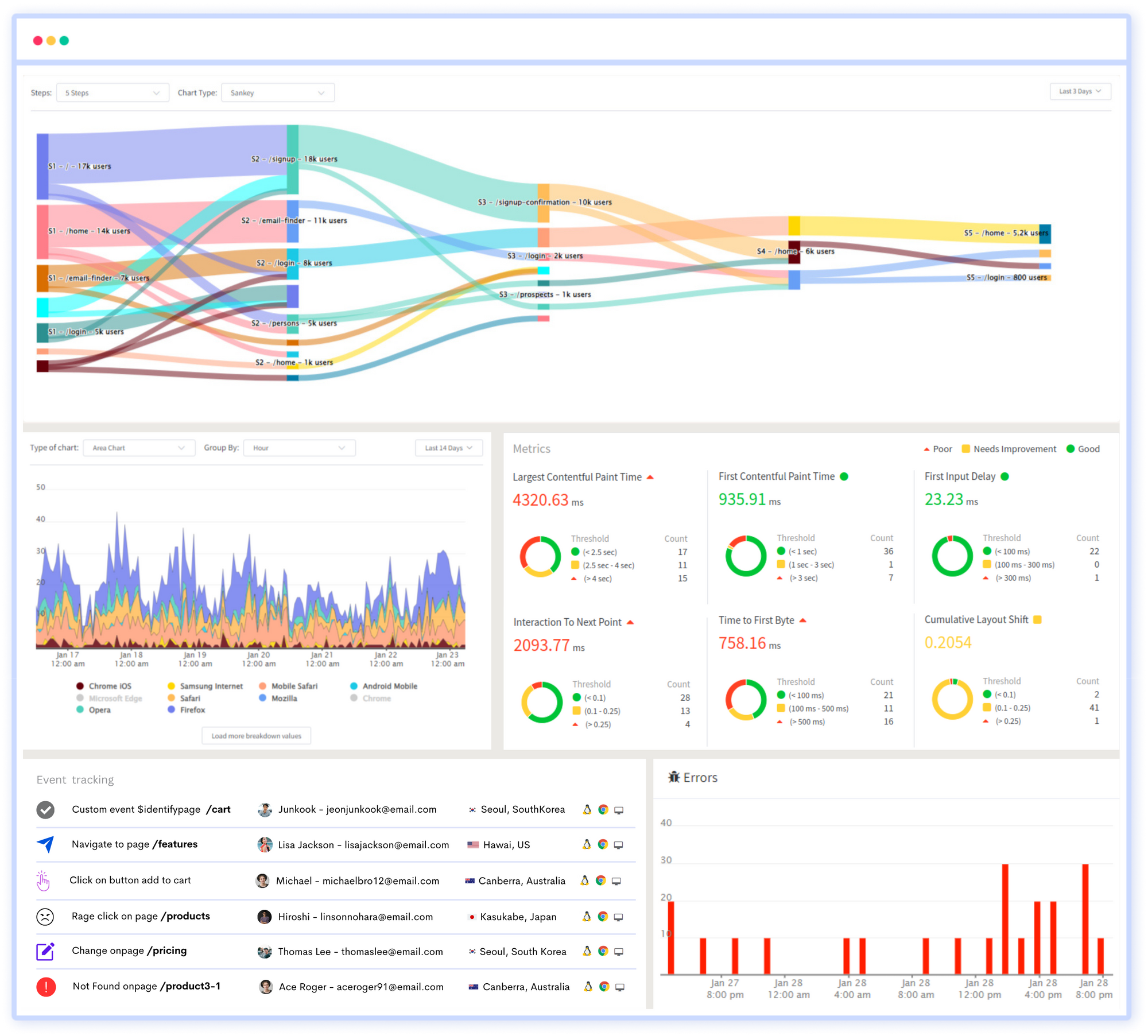
With product analytics feature, you can get deeper insights into how users are interacting with your product and identify opportunities to improve. Drive understanding, action, and trust, leading to improved customer experiences and driving business revenue growth.
Try ReplayBird 14-days free trial
Keep Reading about Conversion Funnel Analysis
